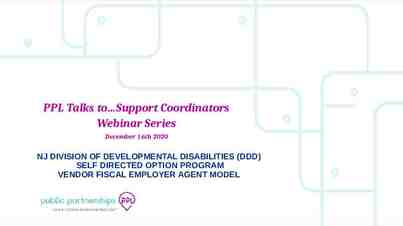GENERATIONAL ESTATE PLANNING PRESERVING THE FAMILY VACATION HOME
18 Slides3.13 MB
GENERATIONAL ESTATE PLANNING PRESERVING THE FAMILY VACATION HOME SEATTLE PORTLAND WASHINGTON, D.C. NEW YORK SPOKANE BEIJING
Biographical Information William O. Etter (“Billy”) is a shareholder and chair of the Trusts, Estates and Charitable Organizations practice group at Foster Garvey PC, a northwest based law firm with offices in Spokane, Seattle, Portland, Washington D.C. and New York. In addition to his trusts and estates practice, Billy represents organizations in the design, implementation and operation of Employee Stock Ownership Plans (“ESOPs”). Billy received his Juris Doctorate (JD) from the University of Arizona and a Master of Laws (LLM) in taxation from New York University. 2 foster.com
Overview – Preserving the Family Vacation Home (FVH) I. Family Vacation Home (FVH) – Unique Issues II. Potential Ownership Structures III. Family Limited Liability Company IV. Conclusions 3 foster.com
I. Family Vacation Home – Unique Issues A. Unique Emotional Asset Family Traditions Sweat Equity B. Unique Legal Asset Illiquid Asset Not Fungible “Phantom Costs” Tax Issues 4 foster.com
II.Potential Ownership Structures A. Direct Ownership B. Trust Ownership C. Family Limited Liability Company D. Corporate Ownership (C corporation or S corporation) 5 foster.com
II.Potential Ownership Structures A. Direct Ownership 1. Pros Easily Understood Less Expensive 2. Cons Creditor Protection Transfer Restrictions Dispute Resolution 6 foster.com
II.Potential Ownership Structures B. Trust Ownership (Revocable Living Trust) 1. Pros Easily Accomplished by Deed Taxes (Grantor Trust and WA Estate Taxes) Disability Protection Probate Avoidance (State Specific) 7 foster.com
II.Potential Ownership Structures B. Trust Ownership (Revocable Living Trust) 2. Cons Estate Tax Inclusion Not ideal vehicle for multiple parties making capital contributions and sharing expenses Limited creditor protection Disposition after grantor’s death 8 foster.com
II.Potential Ownership Structures B. Trust Ownership (Irrevocable Trust) 1. Pros Creditor protection Removal of asset from grantor’s gross estate for estate tax purposes 2. Cons Amendments are difficult (TEDRA Agreement?) Successor trustee? Giving up control before death? Tax consequences? Not flexible 9 foster.com
II.Potential Ownership Structures C. Family Limited Liability Company 1. Pros Retention of control at parent level Gift of minority interests in real estate Transfer restrictions Flexibility (amendment of LLC Agreement for changing circumstances) Combines advantages of partnership/pass-through taxation with flexibility of structure with corporate benefit of limited liability protection 10 foster.com
II.Potential Ownership Structures C. Family Limited Liability Company 1. Pros No adverse tax consequences on LLC termination (or formation) Provides mechanism for dispute resolution Gifting Discounts: Lack of Control and Lack of Marketability Good vehicle for including income producing assets to pay costs Structure ownership for 3rd generation and beyond 11 foster.com
II.Potential Ownership Structures C. Family Limited Liability Company 2. Cons Costs of initial setup “Buy-In” from family members WA Estate Tax Issue (WA resident with out of state real property) 12 foster.com
II.Potential Ownership Structures D. Corporation: C corporation or S corporation Not advisable (don’t want to hold real property in corporation) Tax Traps: LLC that makes S corporation election 13 foster.com
III. Family LLC Structure A. Formation Mechanics 1. Certificate of Formation 2. Initial Report 3. Federal Taxpayer Identification Number (EIN) 4. LLC Agreement 5. Transfer of Real Property 14 foster.com
III. Family LLC Structure B. Tax Issues 1. Real Estate Excise Tax (WA real property) WAC 458-61A-201 – Gifts WAC 458-61A-202 – Inheritance WAC 458-61A-212 – Transaction where no gain recognized under IRC 2. Estate Tax Analysis 3. Gift Tax Analysis 15 foster.com
III. Family LLC Structure C. LLC Agreement – Specific Provisions 1. Overall Structure 2. Transfer Restrictions 3. Continued Expenses (“Phantom Costs”) 4. Usage Provisions 5. Economic Provisions 6. Dispute Resolution (“Impasse”) 16 foster.com
IV. Conclusions 1. LLC structure is preferred option 2. No “turn key” solution; LLC Agreement can be complicated 3. Value in Simplicity 4. Don’t underestimate “phantom costs” to subsequent generations 5. Work out usage details before consulting attorney 6. Flexibility for future members 7. Alternative Options to Shared Ownership 17 foster.com
SEATTLE PORTLAND WASHINGTON, D.C. NEW YORK SPOKANE BEIJING























